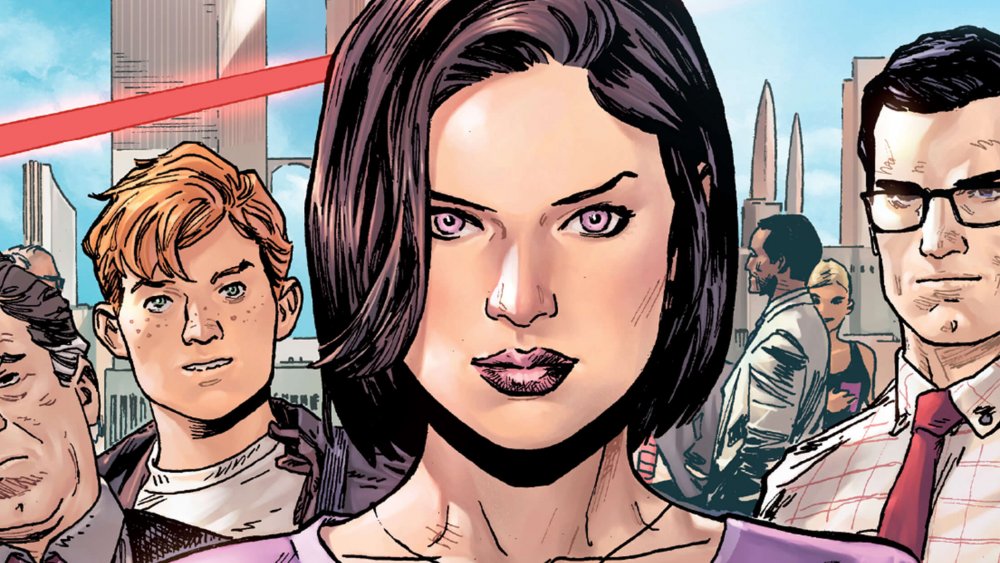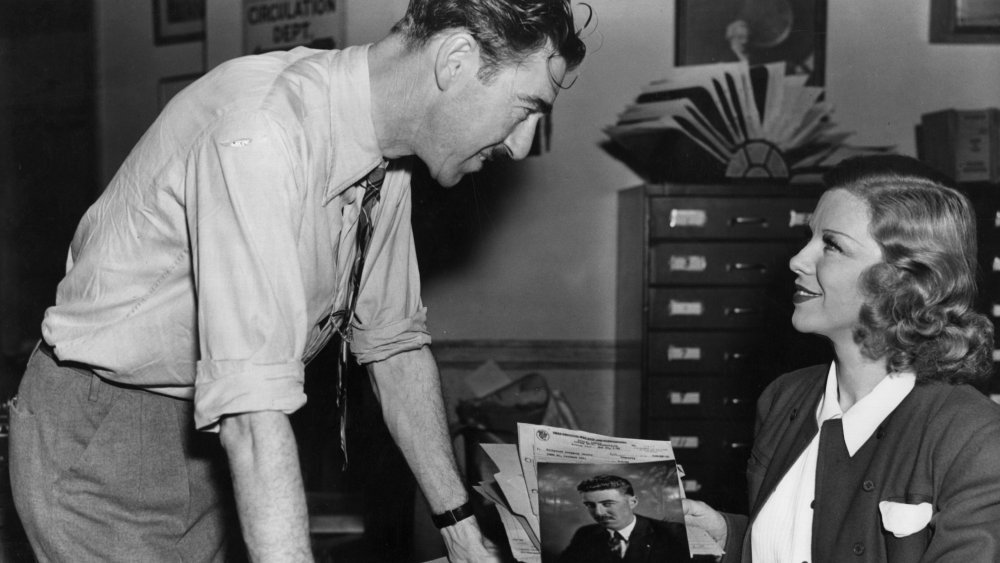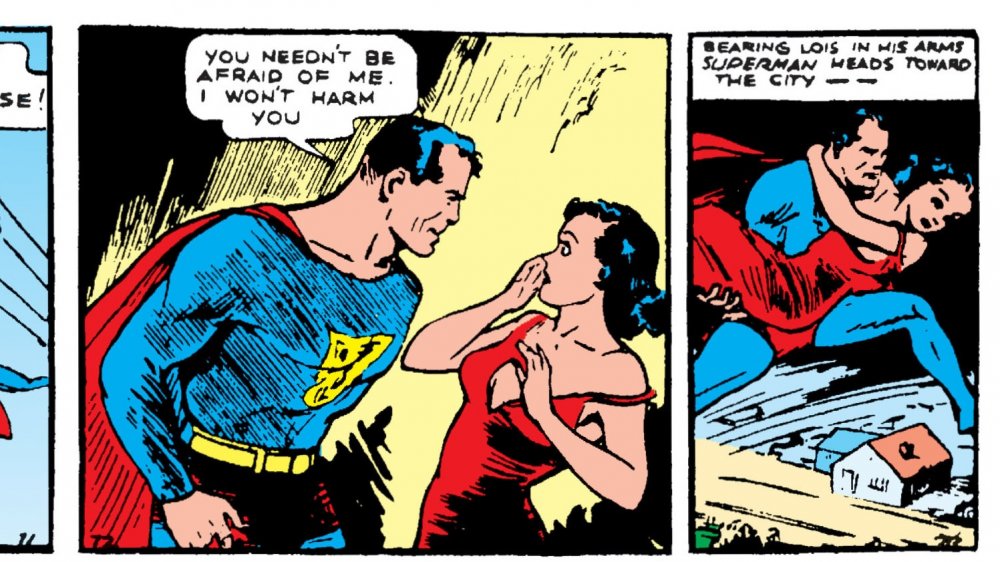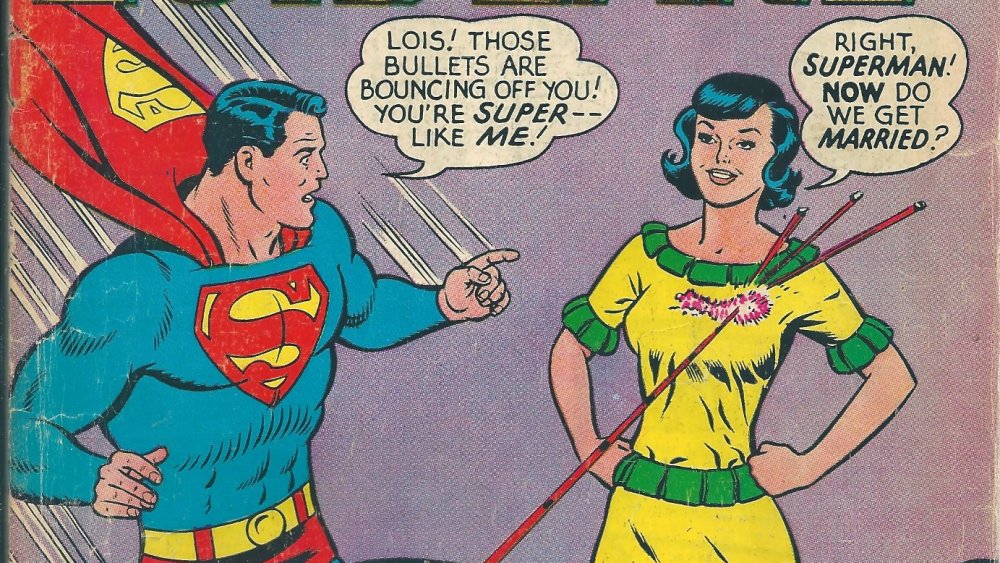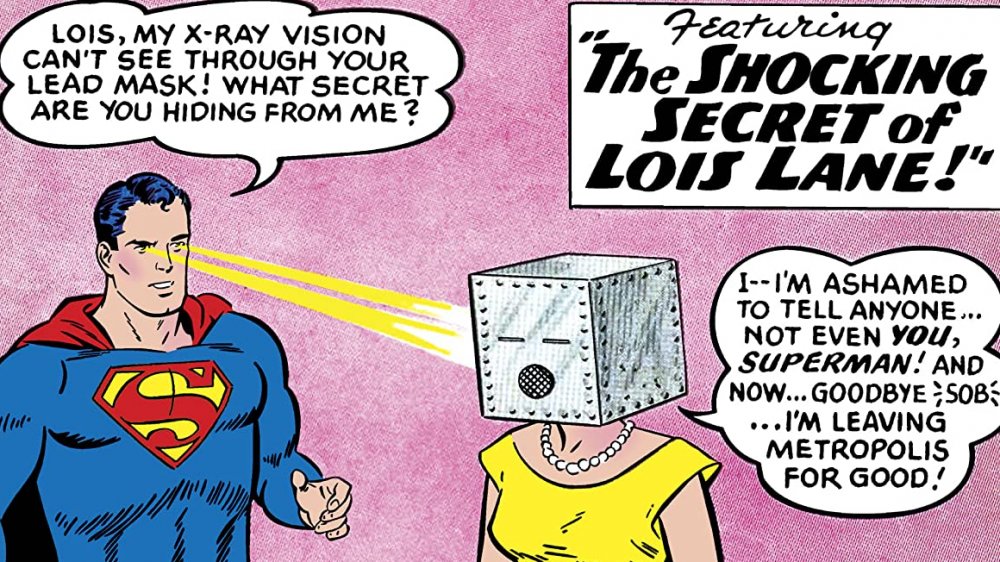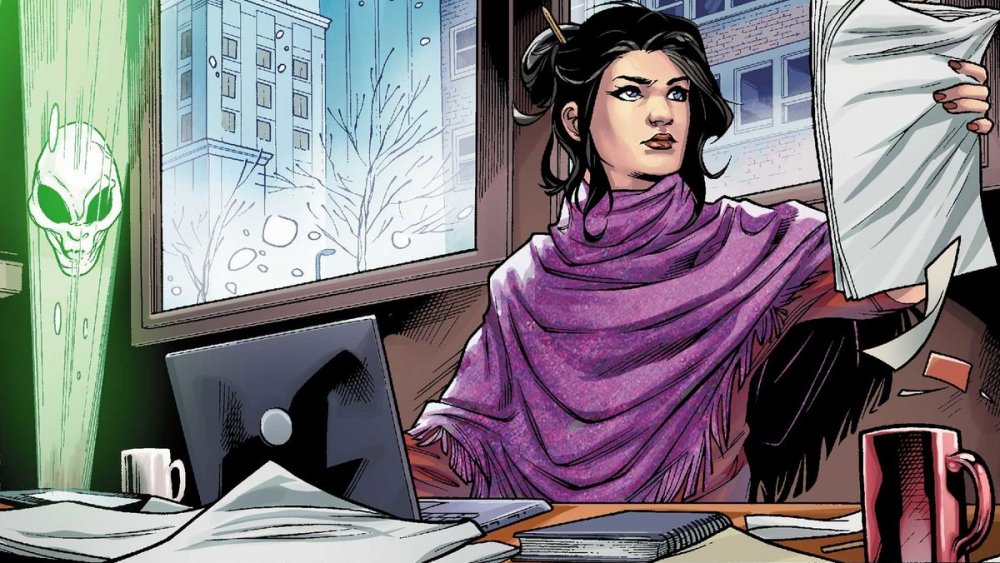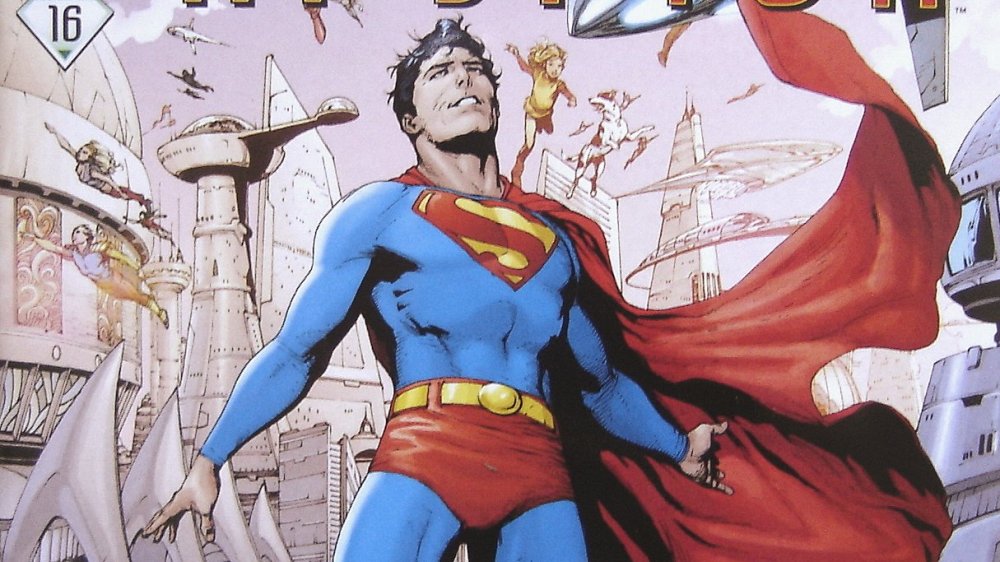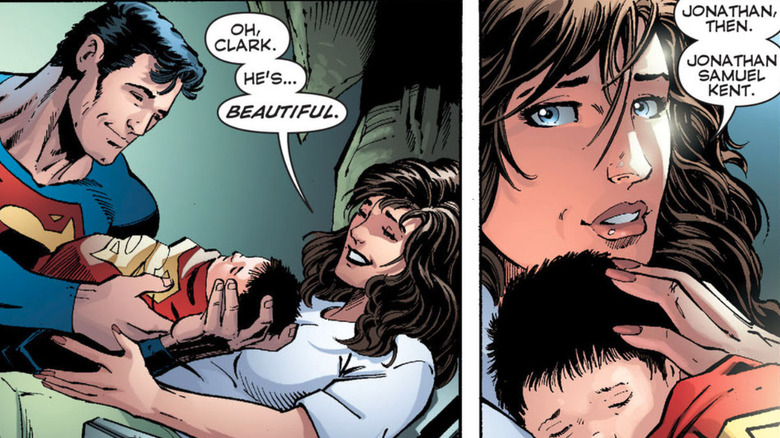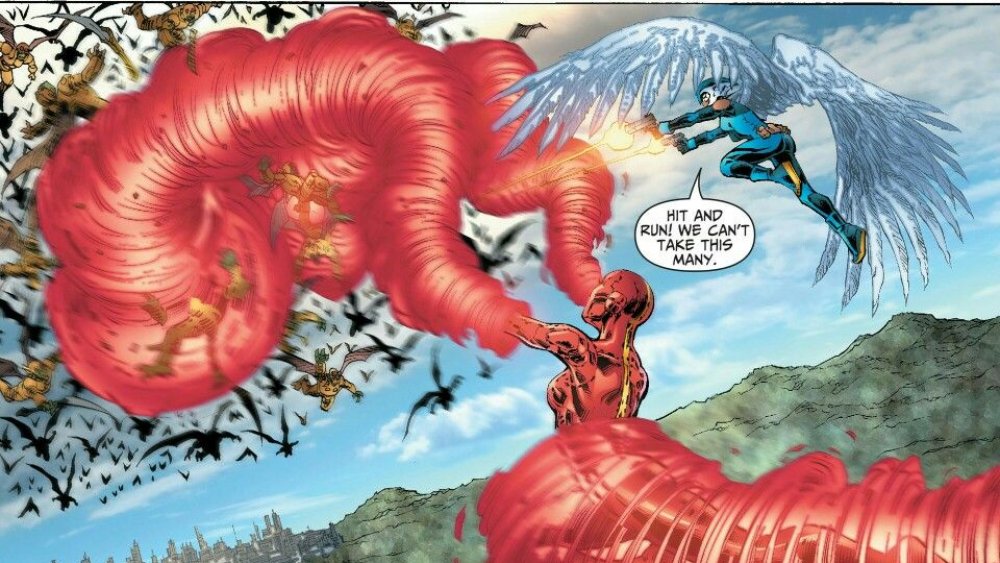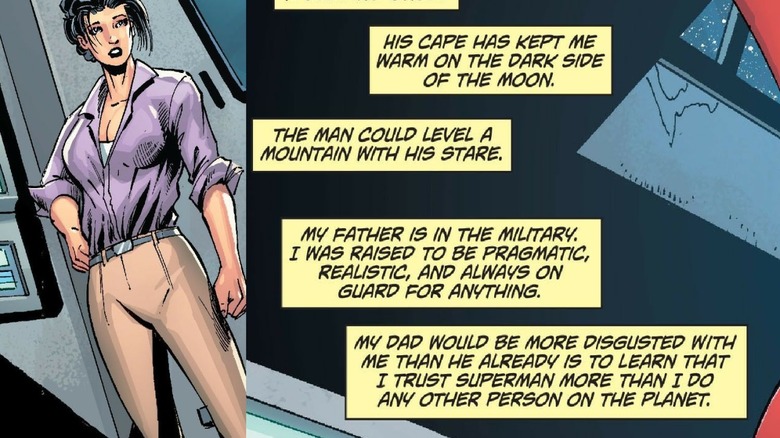The History Of DC's Lois Lane Explained
Superheroes need humans they care about to bring them back down to Earth. This is especially true for Superman, the granddaddy of all superheroes. The Man of Steel has as many fantastic abilities as his fans have old copies of Action Comics: He's a walking god from another planet who can turn back time, see through walls, deflect bullets, and shoot lasers with his eyes. If it weren't for the love of the kindly Kents of Kansas, he'd have left Smallville in the dust and perhaps become a very different kind of strongman. Humanity is what makes Superman, well, super — the powers just let him express the goodness instilled within him on a massive scale.
Thus, the creators of Superman perfected the character's all-important duality: He has powers beyond our wildest dreams, but is, through the love of ordinary Earthlings, more humane than most humans. There is no character more responsible for keeping Clark's feet on the ground than Lois Lane. The intrepid reporter and love of Superman's life has been around since the character's earliest days, giving him a concrete reason to protect Metropolis when truth, justice, and the American way grow a little thin. But Lois is a lot more than just a superhero's girlfriend. This is her story, from her reporting skills to the times she's donned the bright red S herself.
Real-life inspiration
Lois Lane was created by Jerry Siegel and Joe Shuster right alongside Superman himself. Her characterization sprang from a number of places, including 1930s movies and Siegel's own wife. Back in 1988, the Superman writer shared that he wanted Lois to be a hard-nosed working girl, rather than a damsel to be saved by Superman. He based her partially on the character of Torchy Blane, a fictional journalist who searched for scoops in Depression-era double features: "What inspired me in the creation was Glenda Farrell, the movie star who portrayed Torchy Blane, a gutsy, beautiful headline-hunting reporter, in a series of exciting motion pictures," he told Time magazine. "Because the name of the actress Lola Lane appealed to me, I called my character Lois Lane. Strangely, the characterization of Lois is amazingly like the real-life personality of my lovely wife."
Siegel and his wife Joanne were actually brought together by Superman: She modeled for Shuster's original drawings of Lois Lane, and went on to marry Siegel over a decade later.
There from the beginning
Even in the earliest Superman comics, the dynamic at play between Lois Lane and Superman is multifaceted. Lois is frequently unimpressed by her feckless coworker Clark Kent, only to be dazzled when she is saved later by the heroic Superman. This is established in Action Comics #1, when a date between Clark and Lois goes haywire. First off, Lois accepts the date out of boredom, saying she'll go out with Clark "for a change." When a lout interrupts their dance later that evening, she excoriates Clark for not standing up to the bully. Clark is, of course, pretending to be a weak-willed sop to conceal his identity, but he does so reluctantly. When Lois steps in and slaps the jerk, Clark mutters his approval under his breath: "Good for you, Lois!" But of course, he follows up in a much louder voice, telling her to stop. He loves her for being the kind of woman who can't love the man he's pretending to be — a juicy drama fans have loved ever since.
The bully goes on to kidnap Lois. As Superman, Clark gives chase and smashes the criminal's car. He flies off with Lois Lane in his arms, and she's deeply impressed — he's every bit the steel-spined hero she wishes Clark could be. When she sees Clark the next morning, she brushes him off while telling her editor about her experience with Superman. Thus, their dynamic was established.
Digging up the truth
Lois' character is built on tension. Two electric storylines run through her history: Her competitive relationship with Clark Kent, and her desire to unearth Superman's identity. On the one hand, Clark Kent is her rival at work. The pair regularly duke it out to land scoops and earn the favor of their bosses at the Daily Planet. Lois is a lot more aggressive about this than Clark, but it's no mystery as to why: As a woman in a male-dominated industry, Lois knows she has to be supremely good at everything she does.
But of course, Lois' journalistic instincts come into conflict with her burgeoning attraction to Superman. She's into him, but she just can't stop wanting to unearth the real identity of Metropolis' defender. The mystery surrounding Superman and Clark Kent is a key component of Lois' stories in the first few years of the character's history. Frequently in these stories, Superman has to fight off the villain of the week while hiding his identity from Lois — no mean feat when Lois is actively laying traps for him to stumble into. Usually, her snares fail spectacularly, frustrating the ace reporter to no end.
Changing times, changing Lane
Superman changed with the times and so did Lois Lane. The '50s and '60s marked a dramatic shift in mainstream comics toward the cosmic: Sci-fi plotlines flourished and alien nemeses rained down on Metropolis. While Superman was off fighting in the far reaches of the solar system, Lois launched her own incredibly successful series. Superman's Girl Friend, Lois Lane was one of the best-selling titles of the early '60s, frequently showcasing the reporter hatching bigger and bigger plots to convince Superman to marry her.
There's a lot to criticize in this comic, but it's not all swoony girlfriend tropes. Lois' backstory is fleshed out in the pages of this comic, with readers learning that Lois got her foot in the door at the Daily Planet as a teenager, having won a contest to act as a cub reporter for a week. It's here that she first meets Clark Kent, who has also won one of the coveted slots. The pair begin competing almost immediately, with Lois betting Kent she can break more stories than him in their brief stint on the paper. Kent's need to save citizens as Superboy repeatedly gets in the way of his reporting, and Lane comes out on top.
Lois Lane in the modern era
Lois was rebooted after DC's' seminal '80s event, Crisis on Infinite Earths. In many ways, this was a return to form: The sad-eyed wannabe wife vanished, and the hard-nosed reporter of the '40s was restored. This Lois doesn't rely on Superman for rescue and is depicted as a tough journalist willing to put herself in danger to get the truth out there.
Though Lois is still enamored with Superman (and increasingly, with Clark), he's not the only focus of her romantic exploits. She is shown throughout the '80s and '90s having relationships with other Metropolis bachelors, while occasionally going on dates with Kent. Far from the scheming Lois of old, her desire to marry Superman is entirely secondary to her character. The relationship between the pair grows with time, in an organic way. It took until 1996 for Lois and Clark to finally get married. They've largely remained together ever since.
Marrying an alien
Lois Lane's relationship to her superpowered husband is occasionally strained by his alien ancestry. When the Kryptonian city of Kandor appears on the Earth near Superman's Fortress of Solitude, Superman's desire to protect his people puts him at odds with his human wife and in-laws. These Kryptonians refuse to get along with humanity, who they feel entirely superior to. Attempts to make peace quickly go south after a Kryptonian force kills several human police officers.
Human counterattacks lead to an all-out war between the super-strong Kryptonians and humanity's militaries. Lois' father, General Sam Lane, helps invade Kandor. The battle only ends when the Kryptonians figure out how to transport themselves to a new planet on the opposite side of the sun. Superman leaves Earth to look after the new planet, but is ultimately unsuccessful: The planet is destroyed in a plot by Sam Lane. Lois uncovers war crimes committed by her father, and Sam takes his own life.
Following this bleak storyline, Superman takes some time away from Lois to travel and re-learn how to care about humanity. But he never falters in his love for Lois.
Becoming a mom
Perhaps DC was trying to avoid Mallrats' memorable dissection of Lois' ability to carry Superman's son in making the Kents adoptive parents. Either way, the first kid Lois and Clark call their own enters their lives much like Clark entered his Kansas parents': Chris Kent falls to Earth in a Kryptonian spacecraft. Lois and Clark take him in as their own, learning later that he is the child of Superman's nemesis, Zod.
Chris' arrival on Earth creates a gateway that Zod uses to travel out of the Phantom Zone, where he's been imprisoned. Zod attacks the Earth and attempts to reclaim Chris as his son. Being raised by the Kents, however, he rebels against his biological father and protects Lois and Clark from Zod. After a war between Zod and Earth ensues, Superman is able to send the evil Kryptonian back to his prison dimension for good. To keep this from happening twice, Chris sacrifices himself and voluntarily goes to the Phantom Zone as well.
Years later, Superman and Lois go on to have a son of their own named Jonathan Kent. He's the spitting image of his dad, from whom he inherited his powers, but his spitfire personality is a whole lot like his mom's.
Occasionally a superhero
Over the years, writers have found ways to make Lois a little more than human. In early takes on Lois, she occasionally finds herself in possession of powers with a shelf life, often through fabulous feats of super science. Whenever Lois briefly becomes a superhero, she usually takes on the identity of Superwoman, and feels what it's like to live as her ultra-powerful husband. Generally speaking, she's a fan.
A few very different takes on superpowered Lois exist as well. In a parallel timeline, Lois and Clark are both killed by Darkseid and his forces from the planet of Apokolips. Her father Sam survives and manages to upload her consciousness into a robotic body, making her that universe's Red Tornado. Lois teams up with the few surviving superheroes of Earth and works to expel Darkseid and his army.
Other mishaps (and dream sequences) have turned Lois into Elastic Lass, Green Lantern, and even a bad guy from time to time. In one alternate timeline where she marries Lex Luthor, she becomes the supervillain Leopard Lady.
Back to the beginning
The most recent reboots of the DC universe have put Lois and Clark back at square one. The New 52 turned Lois back into a reporter unaware of Clark Kent's double life. Of course, forces drive the pair together, and they marry and have a child — if there's anything comics love better than a reboot, it's following up a fresh start with the same old story.
Lois and Clark hold on to their family after the DC timeline was again rebooted as part of the DC Rebirth event. Lois' investigative skills particularly come in handy when she begins to look into the disappearance of her alternate self. That's right: Lois Lane is such a good reporter, she's figured out her bizarre existence as a multiply-rebooted comic book character. These timelines eventually merge after a time-space battle with the trickster villain, Mr. Mxyzptlk.
Stories post-convergence have refocused on Lois' career, to make wider points about the state of journalism and the media. Recently, she has been portrayed as a White House reporter dealing with the open antagonism of the president. Just as she was in the beginning, Lois Lane is one woman you do not want to mess with.
